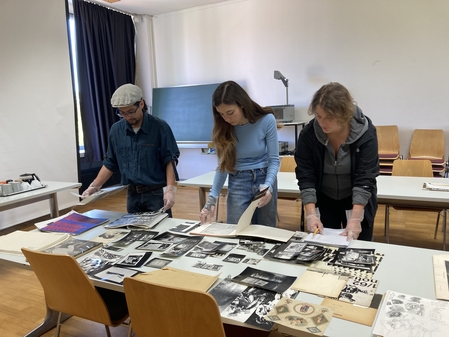Art History and Aesthetics Investigates: The Kunsthochschule in Five Decades (1910-1960)
The research of Art Studies (Prof. Kai-Uwe Hemken) on the history of the Kunsthochschule Kassel is picking up speed again: After the pandemic had massively slowed down the activities (archive visits, interviews, library research), Prof. Hemken with the support of his assistant Constanze Venjakob (M.A.), has once again gathered a group of students of Art Studies in order to open up the history of the Kunsthochschule of the years from 1910 to 1960. The previous research, which was also carried out with a group of students as part of a project seminar by Prof. Hemken, is now completed by the first further findings.
In brief, it can already be stated that Carl Bantzer, former director, under pressure from the students of the time and under the impression of the November Revolution, had given the students a greater say and had set up a program to support the students (prizes, exhibitions). In the 1920s, the academy in Kassel was not only a stronghold of Expressionism and New Objectivity in Germany, but was also considered, along with the academies in Berlin, Breslau, Düsseldorf and Königsberg, to be one of the most progressive training centers for budding artists. A predicate that was explicitly named by the Ministry for Science, Art and National Education in Berlin. The fact that the art academy was closed during the National Socialist era due to previous cost-cutting measures on the part of the ministry does not correspond to the facts: Rather, in the spring of 1935, a Nazi scholarship program was established by elite students who came from all over the national territory. Prof. Kay Nebel had implemented this program together with Prof. Ludwig Thormaehlen (formerly of Kronprinzenpalais), who had been specially sent to Kassel for this task. One of the scholarship holders at the time made it to the Great German Art Exhibition in Munich three times and was given a full-page illustration in a propagandistic art magazine of the time.
In the 1950s, the college included a number of avant-garde artists of the 1920s, for example Hans Leistikow, Fritz Winter and Theo Otto. There was intensive exhibition activity (in close cooperation with the Kunstverein Kassel), which could point to a comparable commitment in the 1920s and had already taken place before the first documenta. A presentation of works by students and professors took place parallel to the first documenta at the Kunstverein. It should not go unmentioned that a special accompanying program was also realized at that time, in the context of which lectures by Johannes Itten and Tut Schlemmer were offered. Also the legendary exhibition 'Die gute Form' (Max Bill) was shown in the rooms of the then Werkakademie (later Kunsthochschule).
The research of art science in Kassel finds support from not a few institutions and personalities all over Germany, among others: Landesmuseum Kassel, Stadtarchiv Kassel, Staatsarchiv Marburg, Von der Heydt Museum Wuppertal, Stiftung Thormaehlen, Kunsthalle Kiel.

